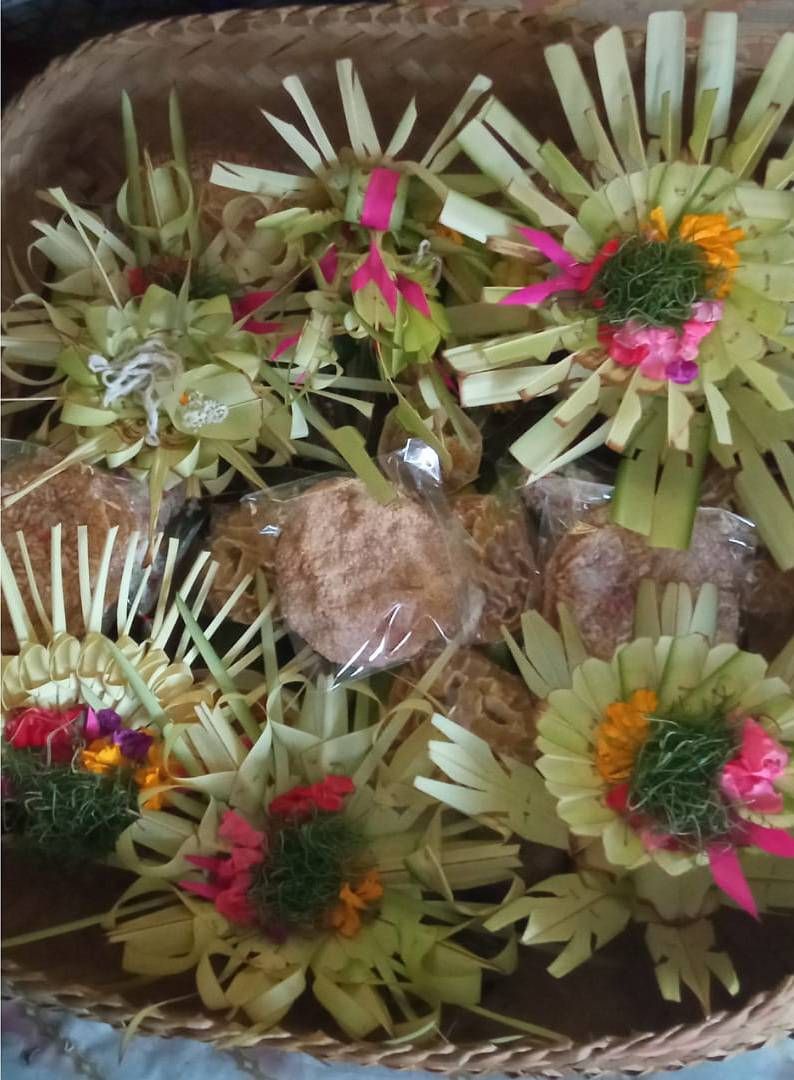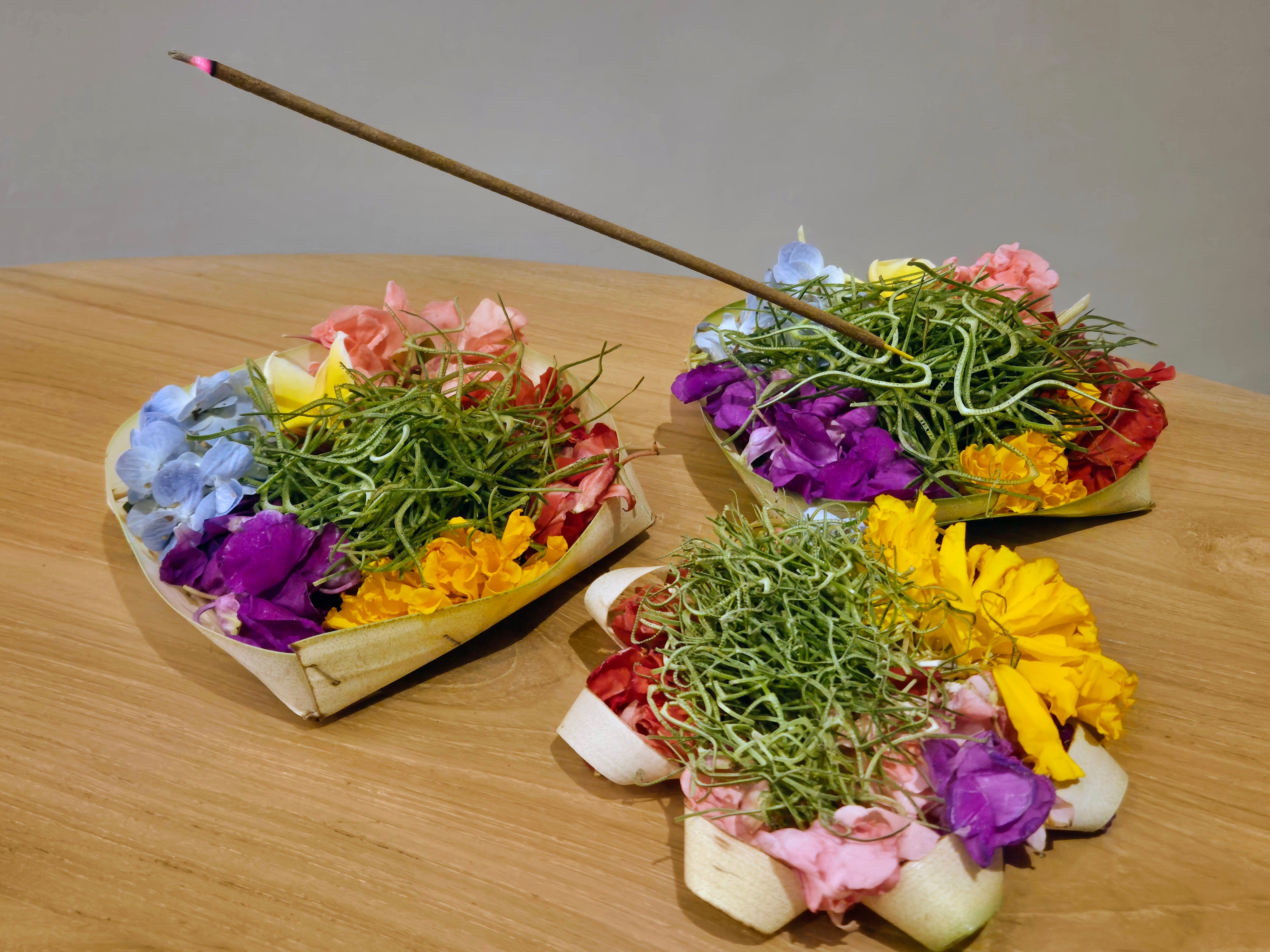Balinese offerings otherwise known as "Canang Sari"
In Bali, the daily ritual of placing canang sari—beautiful woven leaf containers filled with flowers, rice, and incense—is one of the island’s most distinctive cultural traditions. These offerings are typically prepared by Balinese women as an expression of gratitude and devotion to the gods. You’ll find them everywhere: on temple steps, in front of homes, on shop counters, at hotel entrances, and even adorning scooters and sidewalks. In truth, they can be placed almost anywhere, turning ordinary spaces into moments of quiet spirituality.
Each element inside a canang sari holds a symbolic meaning, reflecting the balance between good and evil, the harmony of nature, and the gratitude for life’s blessings. They are usually crafted fresh at home every morning, though many locals purchase them ready-made from small market stalls for just a few thousand rupiah. If you’d like to take part in this meaningful Balinese tradition, you can easily join in by offering one yourself during your stay.
The meaning behind Balinese offerings
Canang sari — the small yet beautifully intricate offering seen throughout Bali — holds a deep spiritual significance in Balinese Hinduism. More than just a daily ritual, it represents a heartfelt expression of gratitude, devotion, and balance between humans, nature, and the divine. The word “canang” translates to “beautiful”, while “sari” means “essence” — together symbolizing the essence of beauty and sincerity in one’s devotion.
Each canang sari is a reminder of harmony — between people and the natural world, between the seen and unseen, and between gratitude and humility. Through this simple act of offering, Balinese Hindus reaffirm their connection to Sang Hyang Widhi Wasa (God) and the spiritual rhythm that guides daily life on the island.
Placement and Purpose: Where Offerings Are Put Matters
Canang sari offerings are usually placed in various locations as an expression of gratitude and prayer to Sang Hyang Widhi Wasa (God) in Balinese Hindu tradition.
The placement depends on the purpose and context of the offering, but here are the most common places:
1. At Home
- Shrine (sanggah/merajan): the family temple in the yard, offered to the gods.
- Entrance gate: to ask for protection from negative forces.
- Kitchen: to give thanks for food and daily sustenance.
- Vehicles (car/motorbike): for safety in travel.
2. At Temples or Sacred Places
- On main shrines in the temple: such as Padmasana or other shrine.
- In the temple courtyard: placed before or after praying.
3. At Workplaces or Businesses
- On the work desk or cashier counter: to bless work and income.
- At the entrance of shops or offices: for protection and good fortune.
4. At Crossroads (Catus Pata)
- Part of bhuta yadnya offerings, made to maintain balance between humans, nature, and unseen spirits.
5. In Nature
- At the beach, rice fields, gardens, or mountains: usually during special ceremonies like melasti (purification), mapag toya (welcoming water), or other rituals for nature cleansing.
Canang sari designs in depth
The Symbolic Meaning Behind Each Element of a Canang Sari
Every element in a canang sari has a deep symbolic meaning in Balinese Hindu tradition.
It’s not just flowers and leaves — it’s a form of communication between humans and God, symbolizing balance, gratitude, and devotion.
1. Ceper (Base or Tray)
- Usually made from coconut leaves, woven into a small palm-leaf tray.
- Meaning: symbolizes the earth — the foundation of life and where humans stand.
2. Peporosan (Core Component)
- Made of betel leaf, areca nut, lime, and gambier.
- Meaning: represents the Tri Murti — the three main aspects of God:
- 🕉️ Betel leaf = Brahma (the Creator)
- 🌿 Areca nut = Vishnu (the Preserver)
- 🔥 Lime = Shiva (the Destroyer)
3. Flowers (Puspa)
Placed on top of the peporosan.
Each flower color and direction carries a specific spiritual meaning:
- ⚪ White (East) → Dewa Iswara → purity and clear mind.
- 🔴 Red (South) → Dewa Brahma → courage and energy.
- 🟡 Yellow (West) → Dewa Mahadeva → prosperity and success.
- 🟢 Blue/Green (North) → Dewa Vishnu → peace and harmony.
Together, the flowers represent the four directions and the balance of life — a reminder that harmony exists when all aspects of the universe are in balance.
Common every day balinese offering types
Canang sari can be made on a ceper (woven coconut leaf tray) or a banana leaf, but both carry the same spiritual meaning — an offering of gratitude and devotion to God.
The difference lies only in function and artistry:
- The ceper is often used in temples or sacred places and may be crafted beautifully as a form of Balinese artistic expression.
- The banana leaf canang is simpler and more practical for daily offerings.
Whether the ceper is small or large doesn’t change its meaning — the beauty and size are a matter of art and aesthetics, not spirituality. What truly matters is the sincerity of the heart behind the offering.

More balinese offering types, typically used for larger ceremenoies
In banten gede (big ceremonial offerings), canang is usually included, but only as a part of the larger offering.
The main offering uses more elaborate types of canang, such as:
- Canang rebong
- Canang burat wangi
These are often decorated with flowers, coconut leaves, and bamboo, and are placed on top of the main banten — like banten pejati or banten gebogan.
So even though there is a canang on it, the whole offering is not called canang sari — it’s called banten, depending on the ceremony.

Experiencing the Tradition of Balinese Offerings Yourself
One of the most beautiful ways to connect with Balinese culture is by experiencing the offering tradition firsthand. Whether through a spiritual purification ritual (melukat) or by joining a local family to make your own canang sari, these experiences offer a deeper appreciation for the island’s harmony between humans, nature, and the divine.
Joining a Melukat (Purification Ritual)
Across Bali, sacred water temples such as Tirta Empul in Tampaksiring or Pura Gunung Kawi Sebatu offer visitors the chance to take part in a melukat — a traditional Balinese purification ceremony.
Before entering the water, participants usually prepare or are provided with a small canang sari offering to place at the temple shrine. This gesture is a form of gratitude and respect before beginning the ritual.
Some temples and local guides offer complete melukat experiences, where everything — from sarong rental to the canang sari — is prepared for you. However, bringing your own offering can make the ritual more meaningful, as it carries your personal intention and sincerity.
Learn to Make Your Own Canang Sari
Many Balinese families and homestays open their doors to visitors who wish to learn how to prepare canang sari themselves. These hands-on experiences are not just about crafting the offering, but about understanding its symbolism — how each color and flower represents different aspects of gratitude, balance, and prayer.
Whether you choose to experience melukat or join a canang sari making class, participating in these traditions is a reminder that spirituality in Bali is not about grand gestures — it’s about sincerity, balance, and harmony in everyday life.
Balinese Offering Q&A
Are Balinese offerings placed down every day?
Yes, canang sari offerings are usually placed every day as an expression of gratitude to God.
However, if someone doesn’t make the offering, it’s not a sin or a punishment — at most, a person might simply feel a sense of guilt or incompleteness within themselves. The daily ritual is more about sincerity and mindfulness than obligation.
Are Balinese offerings always the same?
The basic structure of a canang sari is the same every day — consisting of the base (ceper or leaf), peporosan (core elements), and flowers as the main components.
Still, people often add personal touches like candy, cigarettes, biscuits, or coffee on top. These extras are not required, but they serve as symbols of love, respect, or special intention. The essence remains the same: a heartfelt offering of devotion and gratitude.
Is it offensive to Balinese Hindus if I step on a Balinese offering in the street ?
Canang sari offerings are sacred, but accidentally stepping on one is not offensive and carries no punishment.
That said, it’s considered disrespectful to intentionally step on, kick, or ignore them. Out of courtesy, try to walk around offerings, especially those placed on the ground near doorways, streets, or temples.
Can I touch or take pictures of the Balinese offerings?
Once a canang sari has been placed as an offering, it should not be touched or moved without purpose, as it holds spiritual significance.
That said, taking photos is perfectly fine — as long as it’s done respectfully. Many Balinese people appreciate visitors who show genuine curiosity and reverence for their traditions, provided the offerings and acts of worship are treated with care and understanding.


